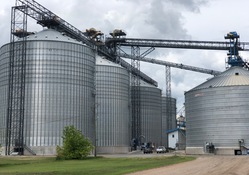4 Strategies for Storing Grain
Oct 09, 2019

As harvest approaches, it’s important to review basic strategies to maintain the quality of stored grain. Here, we outline four strategies to help maintain post-harvest quality, help protect stored grains from insects, and what to look for when monitoring bins post-harvest.
1. CLEANING: Old grain inside and outside grain bins are likely to be contaminated with insects. Full floor aeration often has insects living under the floor as well. Eliminate your chances of immediate infestation of the new crop and make sure your bins are thoroughly cleaned. After cleaning the bin, consider spraying the bin with a pesticide.
2. DRYING: Storage moisture contents for aerated grain for different lengths of storage time
| Storage Time | Shelled Corn | Soybeans | Wheat and Barley | Sunflowers |
|---|---|---|---|---|
| Following Spring | 15.5% moisture content | 13% moisture content | 14% moisture content | 11% moisture content |
| One Year | 14% moisture content | 12% moisture content | 13% moisture content | 10% moisture content |
| Long Term | 13% moisture content | 11% moisture content | 13% moisture content | 9% moisture content |
3. GRAIN TEMP: Minnesota temperatures allow you to achieve a target stored grain temperature of 25 degrees in the winter. At this temperature, mold and insect activity is almost eliminated. The recommended aeration rate for bins is 0.1 cubic feet of air per minute (cfm) per bushel of grain in the bin. The approximate cooling time would then be 15 divided by 0.1, which is 150 hours.
4. CHECKING STORED GRAIN: Monitor bins often to ensure grain is not going out of condition.
When to inspect:
-
Outdoor or grain temperature exceeds 50 degrees: every 7-14 days
-
Outdoor or grain temperature less than 30 degrees: once every 3-4 weeks
Wet grain tends to heat up even during cold weather. Insect infestations can also impact grain temp with the possibility of raising temperatures to as high as 110 degrees.
Check for insects by:
-
Extracting them from the grain
-
Examining kernels for damage
-
Looking for webbing
-
Detecting off-odors
INFORMATION CONTINUED...
The following tables show the relationship between grain moisture, storage temperature and storage time:
If you have any questions regarding your operations grain storage strategy feel free to contact your merchandiser